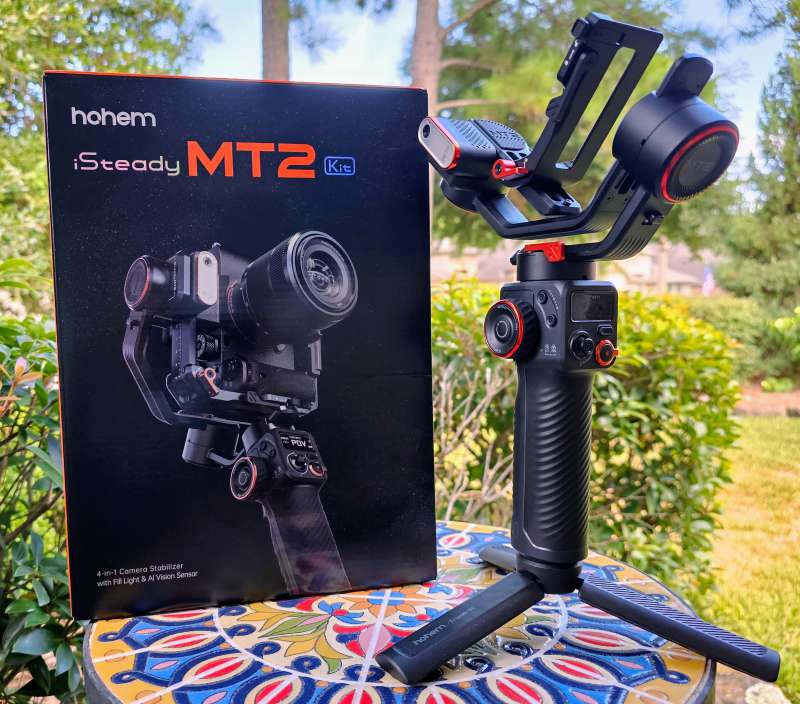
REVIEW – In what seems like a lifetime ago, I intended to make photography/videography my business and not just a hobby. Real life kicked in, though, and I had to get a job that made more than $100 every few weeks taking the odd wedding pictures. My plans were lost to time until a few years ago and the start of the boom of individual content creators. Photography has taken a back seat to video, and it is hard to capture eyeballs with substandard equipment and shaky pictures. A professional quality gimbal would be one of my first purchases as I returned to the hobby. I’ve had a few over the years, but when I saw the specs for the Hohem iSteady MT2 gimbal I was intrigued. Would it live up to my admittedly high expectations?
What is it?
The Hohem iSteady MT2 is a professional grade camera stabilizer (also called a gimbal) that will help you take rock-steady photos and videos. Most gimbals are designed for a specific class of device – a smartphone, an action camera, a DSLR, etc. In fact, Hohem makes those types of gimbals as well. But the MT2 uses a pretty ingenious mounting system that will connect to pretty much anything you want – all of the above and perhaps more.
What’s in the box?
- The Hohem iSteady MT2 gimbal that has a standard tripod mount on the bottom of the handle so you can attach it to monopods, tripods, etc.
- A removable AI module – more on this shortly
- A tripod leg set that uses the standard tripod mount
- A unique slide rail system that acts as host to your device and can attach to the gimbal in either portrait or landscape mode
- Various mounting hardware that couples with the slide rail system to handle the variety of devices
- A bag of cables that allows you to connect the gimbal to your device for both charging and controlling the device
- A black zippered carrying case to hold all of the above
- An instruction manual
Design and Function
Before I get started on the basic gimbal features, let’s talk a little about artificial intelligence, specifically the AI module that the Hohem iSteady MT2 gimbal kit comes with (the standard MT2 not in a kit does not come with this module, but it is available to purchase separately). At first glance, the module looks more like a fill light than a smart tracker:
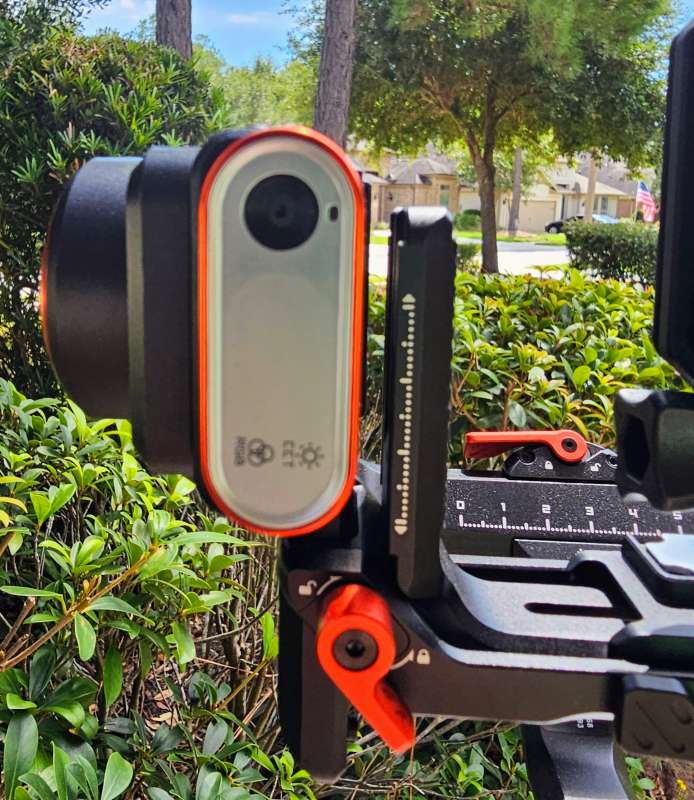
The module attaches to the gimbal magnetically. You might think this could lead to accidentally losing the module, but the magnetic connection is very strong. So, to use the module simply turn it on. Like other AI devices, the Hohem iSteady MT2 gimbal relies on hand gestures to know how to track a subject. Make the OK hand gesture for a second or so, and a green light will turn on to indicate that the gimbal is in auto track mode. Similarly, hold your hand up making the stop gesture and the gimbal will drop out of auto track mode. You can make the goal post gesture (tips of the thumbs touching and index fingers in the air) to adjust tracking to a more specific location – say, perhaps, your face.
If you aren’t going to use the AI module, you can remove it:
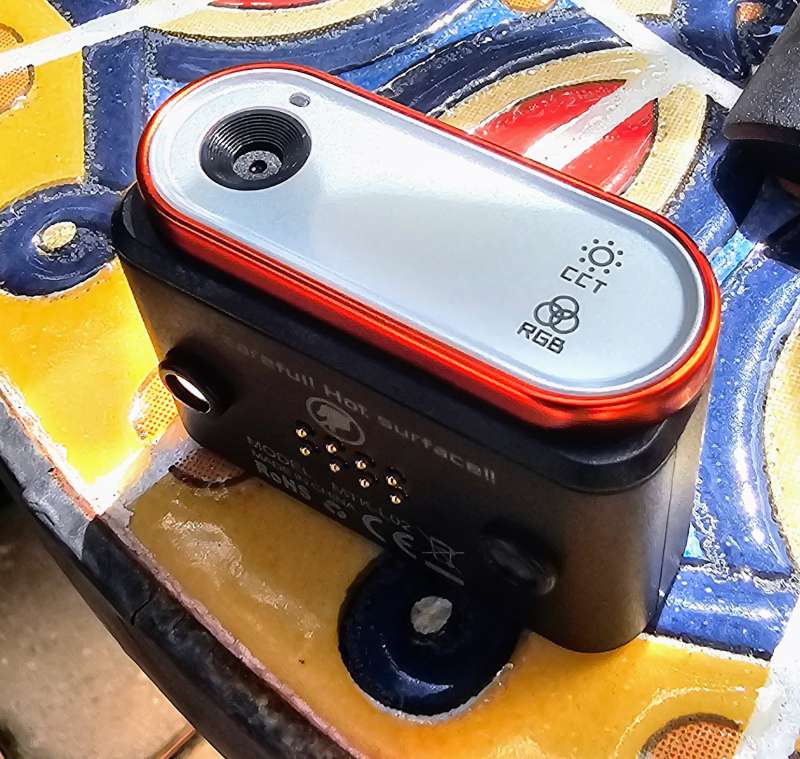
Now let’s take a look at the slide rail mounting system. There is an L-shaped bracket that acts as the host between the device and the gimbal, and a second slide rail that connects the device rail to the L-bracket. When connected, everything locks in place and the combination can be attached to the gimbal in either portrait or landscape mode. Hohem also includes a magnetic screwdriver (the silver device in the picture below) that you can use to adjust where some of the mounts sit – a necessity to ensure the gimbal is properly balanced. The picture shows the slide rail with the smartphone mount.
Here are the controls the Hohem iSteady MT2 gimbal offers, starting off with the front panel:
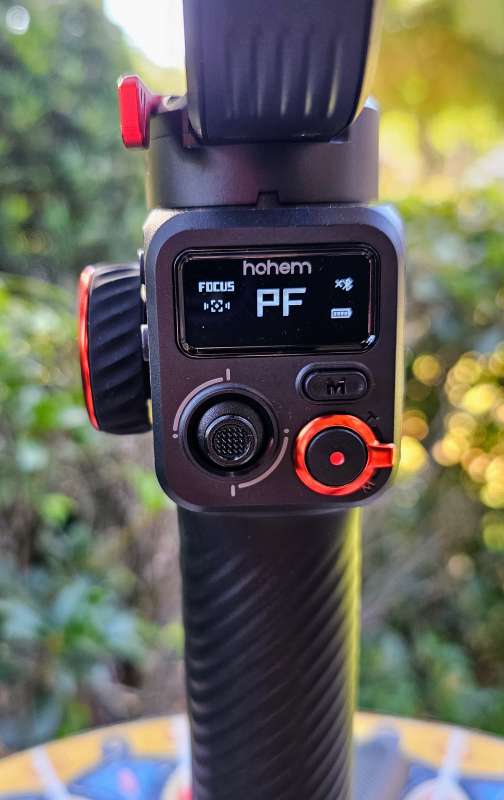
The joystick on the bottom left controls the manual movement of the gimbal. The orange wheel on the bottom right handles zoom while the button inside the wheel handles the device shutter. The button above the zoom wheel is for switching modes on the gimbal (plus enables Bluetooth pairing and forgetting Bluetooth connections). At the top is the OLED display which gives you various bits of information (battery indicator, Bluetooth status, etc.). Front and center is the mode display: PF (Pan Follow), PTF (Pan and Tilt Follow), L (All Lock), POV (All Follow), S (Sports Mode) and ICP (the shot made famous in the movie Inception, a slow 360 degree on the main axis).
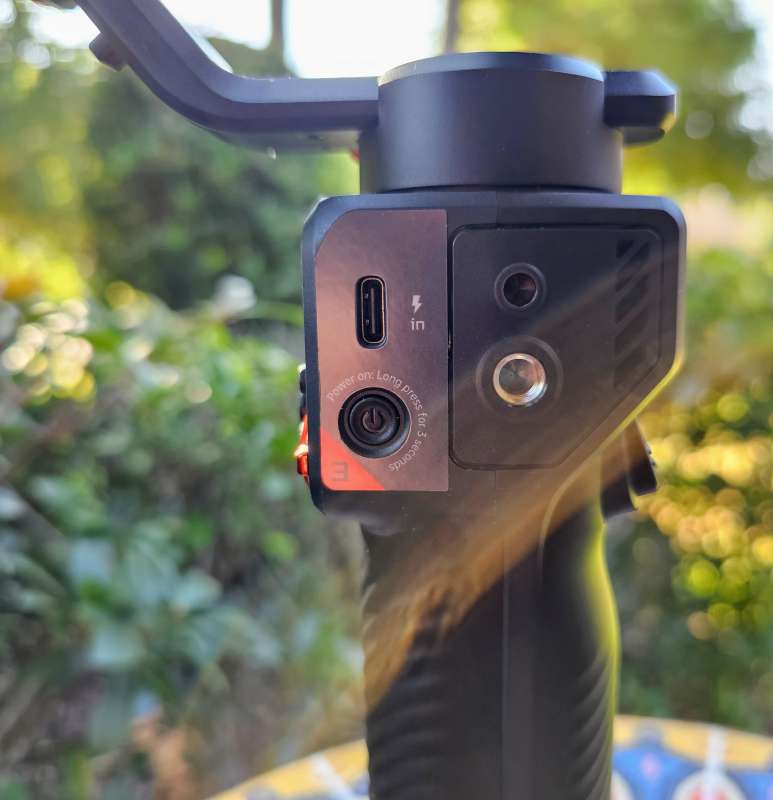
On the right side, there is a USB-C charging port for the gimbal, the power on/off switch, a positioning hole (not entirely sure what this is used for), and finally a standard tripod mount (which would probably come in handy for those Inception shots).
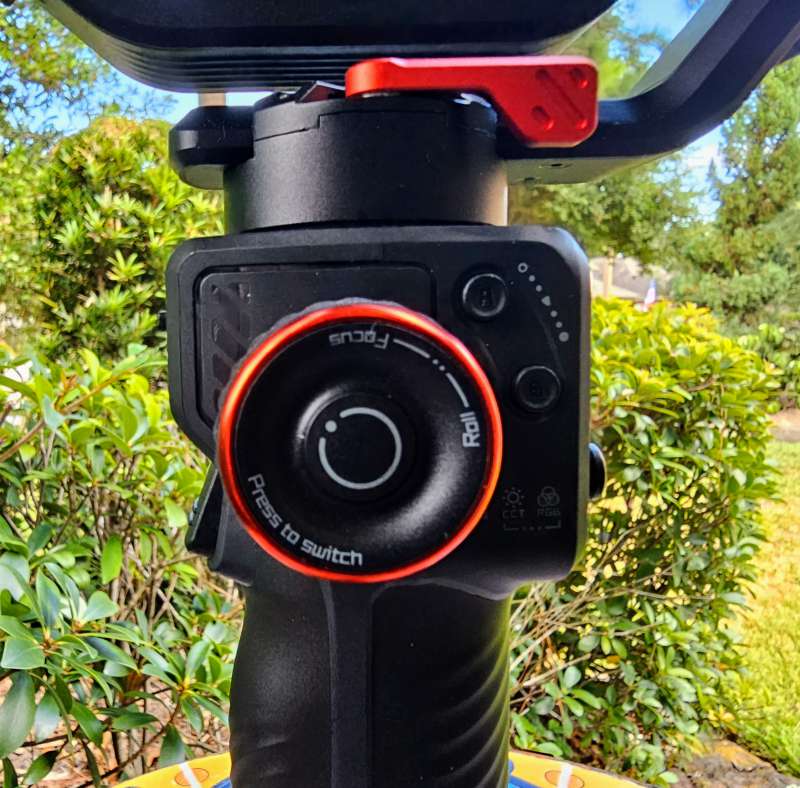
The right side of the Hohem iSteady MT2 gimbal has the multifunction wheel to control various types of shots and actions. There is also an A-B switch which helps with taking motion time-lapse videos.
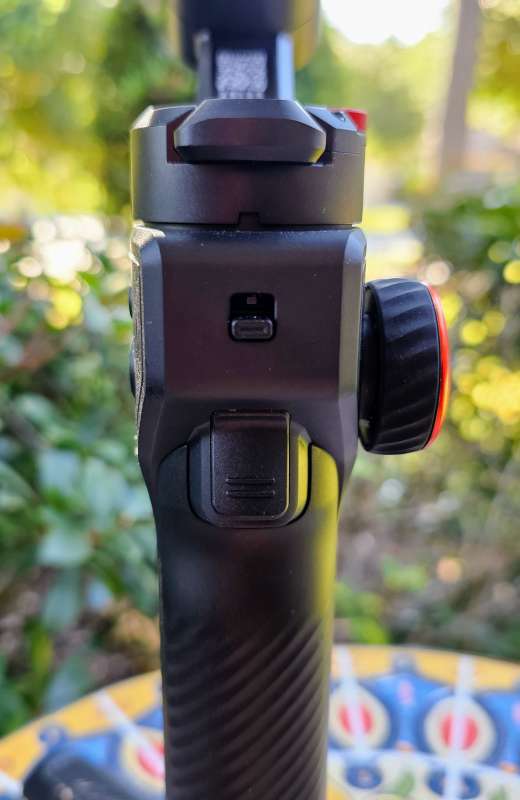
On the back side of the Hohem iSteady MT2 gimbal, there is a trigger that performs various actions. One press sets the gimbal into Sport mode, two presses will move the gimbal (and your device) back to the center position, and much more.
Just above the trigger is the axis lock switch. Each axis has its own lock, very useful when you are done using the gimbal and want to put it back in the case. Rather than the origami folds most gimbals put you through to lock the gimbal for transport, the MT2 has the 3 switches to lock each arm in the proper position. Just remember to unlock these switches next time you take the gimbal out of the case – if you don’t, you will get an error 3 on the OLED display which tells you the MT2 can’t move the various arms. Plus, you’ll hear the motor strain and I imagine doing that too often is not a good thing for your gimbal.
As previously mentioned, this gimbal can handle pretty much any device you have. Let’s take a look at my collection starting with the smartphone slide rail and my Samsung Galaxy S23 Ultra.
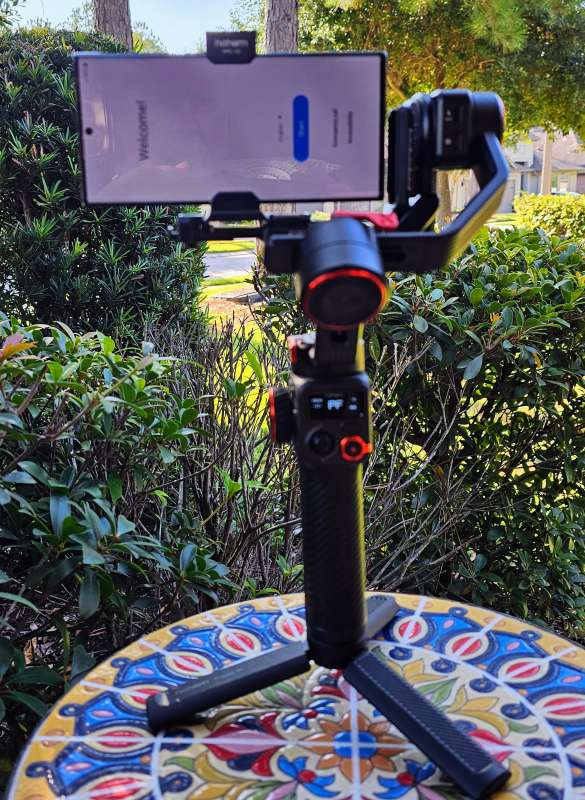
Here the phone is mounted in landscape mode. The dedicated slide rail for smartphones uses a spring-loaded clamp to hold the phone in the mount. The S23 Ultra is one of the largest smartphones around, and the mount was able to handle it without my feeling like I had one of those chest-spring exercise devices trying to pull out far enough to accept the phone.
Controlling the Hohem iSteady MT2 gimbal from a smartphone requires downloading and installing the Hohem Joy app on the phone and connecting via Bluetooth. The app works great and is very helpful as you learn more about the gimbal. You can also connect the phone to the gimbal with a USB-C to C cable to keep your phone’s battery topped off while using the gimbal.
Next up is the DSLR. I have an old Nikon camera which was made before anyone thought about controlling the camera with an external device. All of the ports on my camera are outbound – mini-HDMI to watch playback of recorded material, etc., and the camera does not have Bluetooth. This is not a fault of the MT2, but rather the age of my device. The odds are very much in your favor if your device is less than 5 years old and it didn’t come out of a gumball machine. Just for illustration purposes, here is the camera in Portrait mode:
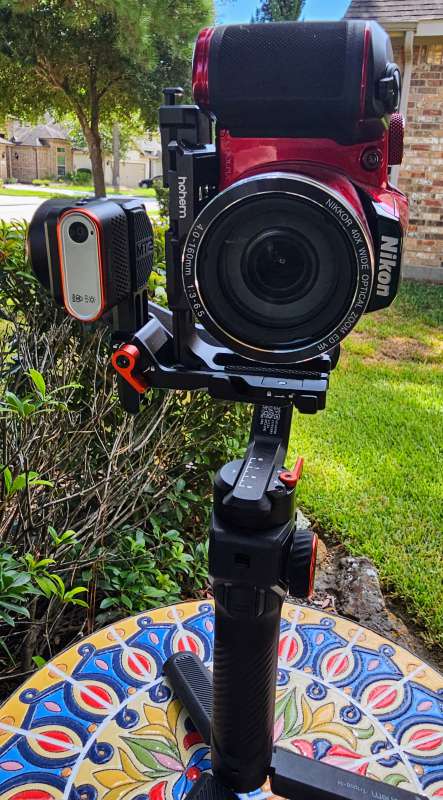
Finally, we will end up with my Hero GoPro 11 Black, once again back in Landscape mode:
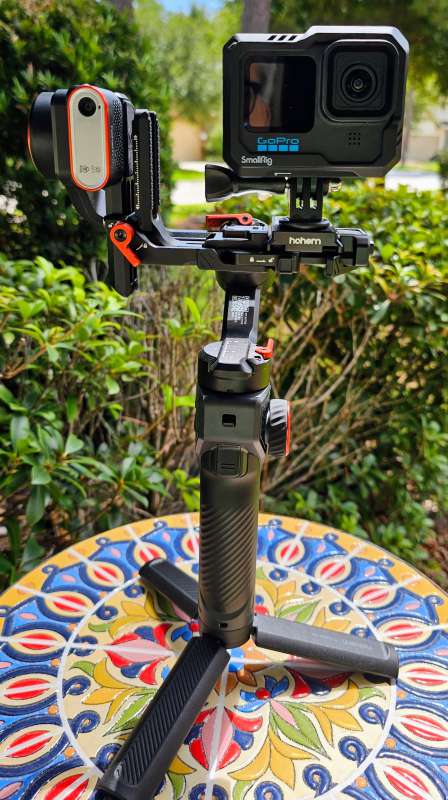
Most newer models of action cameras have Bluetooth built in, and that’s how the Hohem iSteady MT2 gimbal can control the device. There are still some things you have to do through the camera (shutter speed, resolution, frame rate, etc.), but the MT2 does a great job at basic device control.
Does the Hohem iSteady MT2 gimbal live up to the expectations?
An order of magnitude above absolutely.
Let’s be clear about something, though. The MT2 is definitely not for everyone. Setting aside the price (anywhere from 2 to 4 times higher than a single class of device gimbal), there is the fact that the MT2 does much more than most people would need, meaning a steeper learning curve. Plus, most people use just their cell phone and not much else, so something like the MT2 would be hard to justify when there are cheaper and more friendly options available.
But if you are a semi-pro or a professional (or you routinely use multiple devices), a multi-mount gimbal like the MT2 just can’t be beat. Given that the MT2 can control a wide spectrum of devices and won’t take an obscene amount of space in your field bag, the value proposition of the MT2 comes into sharp focus. It is as light as most other gimbals, yet it does so much more. Combined with the AI module, it is much easier to capture impressive cinematic visuals with the Hohem iSteady MT2 gimbal.
What I like
- The speed with which I can change from one device to another
- How easy it is to set up spectacular shots like a night sky time-lapse
- The steady picture no matter the conditions I am shooting in – you know, basic gimbal functionality
What I’d change
- Nothing at all
Final thoughts
Although there are a lot of gimbals on the market, there seems to be hardly any geared towards the pro market. The few I’ve seen are priced so much higher than the Hohem iSteady MT2 gimbal, yet they offer fewer features or innovative design like the MT2. When I first received this to review, my initial thought was that this was going to take some time to learn. I was wrong. Thanks to the app and my phone, I was able to master the gimbal in just a few days, and what I learned immediately transferred over to the other devices I routinely use.
In the end, the answer was yes – the MT2 did in fact live up to my admittedly high expectations.
We’re leaving for a once-in-a-lifetime repositioning cruise in just a couple of weeks. I had resigned myself to a single device (my GoPro), but thanks to the Hohem iSteady MT2 gimbal, my possibilities are relatively endless. I’ll come home with video shot on the right device for the occasion that I can continue to enjoy long after the cruise is over, and thanks to the MT2, that video will look clean and professional.
Price: $329.00
Where to buy: Amazon or Hohem
Source: The sample for this review was provided by Hohem.


